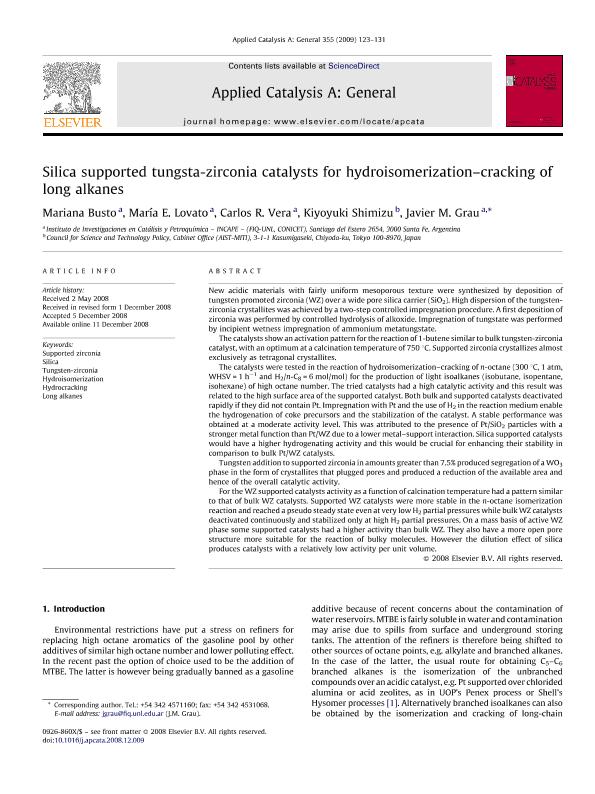Artículo
Silica supported tungsta-zirconia catalysts for hydroisomerization-cracking of long alkanes
Fecha de publicación:
02/2009
Editorial:
Elsevier Science
Revista:
Applied Catalysis A: General
ISSN:
0926-860X
Idioma:
Inglés
Tipo de recurso:
Artículo publicado
Clasificación temática:
Resumen
New acidic materials with fairly uniform mesoporous texture were synthesized by deposition of tungsten promoted (WZ) over a wide pore silica carrier (SiO2). High dispersion of the tungsten-zirconia crystallites was achieved by a two-step controlled impregnation procedure. A first deposition of zirconia was performed by controlled hydrolysis of alkoxide. Impregnation of tungstate was performed by incipient wetness impregnation of ammonium metatungstate. The catalysts show an activation pattern for the reaction of 1-butene similar to bulk tungsten-zirconia catalyst with an optimum at a calcination temperature of 750 °C. Supported zirconia crystallizes almost exclusively as tetragonal crystallites. The catalysts were tested in the reaction of hydroisomerization cracking of octane (300 °C, 1 atm, WHSV=1 h−1 and H2/nC8= 6 mol/mol) for the production of light isoalkanes (isobutane, isopentane, isohexane) of high octane number. The tried catalysts had a high catalytic activity and this result was related to the high surface area. Both bulk and deactivated rapidly if they did not contain Pt. Impregnation with Pt and the use of H2 in the reaction medium enable the hydrogenation of coke precursors and the stabilization of the catalyst. A stable performance was obtained at a moderate activity level. This was attributed to the presence of Pt/SiO2 particles with a stronger metal function than Pt/WZ due to a lower metal support interaction. The supported catalysts would have a higher hydrogenating activity and this would be crucial for enhancing their stability in comparison to bulk Pt/WZ. Tungsten addition to zirconia in amounts greater than 7.5% produced segregation of a WO3 phase in the form of crystallites that plugged pores and produced a reduction of the available area and hence of the overall catalytic activity. For the WZ supported catalysts activity as a function of calcination temperature had a pattern similar to that of bulk WZ catalysts. Supported WZ catalysts were more stable in the n-octane isomerization reaction and reached a pseudo steady state even at very low H2 partial pressures while bulk WZ catalysts deactivated continuously and stabilized only at high H2 partial pressures. On a mass basis of active WZ phase some supported catalysts had a higher activity than bulk WZ. They also have a more open pore structure more suitable for the reaction of bulky molecules. However the dilution effect of silica produces catalysts with a relatively low activity per unit volume.
Archivos asociados
Licencia
Identificadores
Colecciones
Articulos(INTEC)
Articulos de INST.DE DES.TECNOL.PARA LA IND.QUIMICA (I)
Articulos de INST.DE DES.TECNOL.PARA LA IND.QUIMICA (I)
Citación
Busto, Mariana; Lovato, Maria Eugenia; Vera, Carlos Roman; Shimizu, Kiyoyuki; Grau, Javier Mario; Silica supported tungsta-zirconia catalysts for hydroisomerization-cracking of long alkanes; Elsevier Science; Applied Catalysis A: General; 355; 2-2009; 123-131
Compartir
Altmétricas




